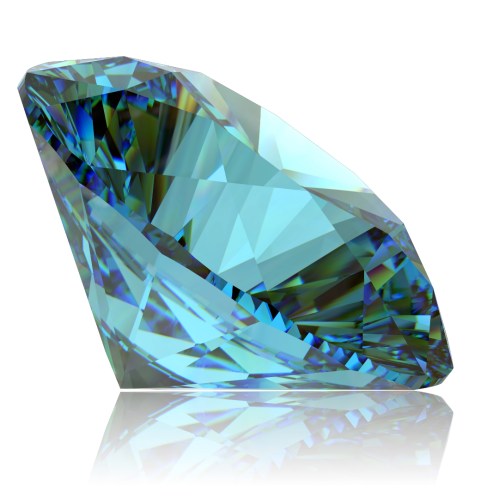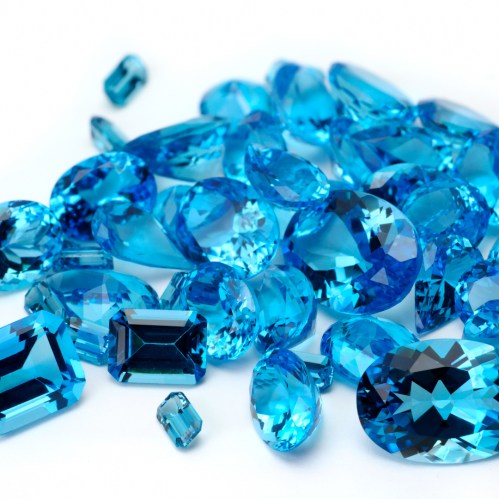Our editors independently select these products. Making a purchase through our links may earn Well+Good a commission
December’s Birthstones Help You Find and Embrace Your Truth Ahead of the New Year
Discover the meaning and symbolism behind each December birthstone—and how to harness their unique energetic powers.

December is an opportunity to reflect on the last 11 months. “Look back on everything that’s happened, all the lessons that you’ve learned, all the beauty that you’ve experienced through this year, how you’ve transformed when things were sticky, and where things were expansive,” says spiritual mentor Sadie Kadlec, author of Crystals: Complete Healing Energy for Spiritual Seekers. You may also be looking forward to the new year, and each December birthstone can guide you during this period, helping you let go of what’s no longer serving you, set intentions that align with your truth, and boldly embrace it.
Experts in This Article
licensed acupuncturist and integrative medicine specialist
multi-modality healer and founder of ASTARA
spiritual mentor and author of Crystals: Complete Healing Energy for Spiritual Seekers
Traditionally, there are three December birthstones—turquoise, tanzanite, and zircon—but Kadlec, along with multi-modality healer Mariah de La Mer, founder of ASTARA and author of Crystal Healing for Women, also count blue topaz as one of them. Each December birthstone is blue, which according to integrative medicine and crystal expert Elizabeth Trattner, AP, DOM, is reflective of the season. “Blue stones, in my opinion, are very representative of winter in the Northern Hemisphere,” she says. Color aside, each has unique physical and metaphysical properties—and whether or you celebrate your birthday this month, you may resonate with one of these stones.
If you want to learn more, Kadlec, de La Mer, and Dr. Trattner break down each December birthstone’s properties, meaning, and symbolism below.
Properties of turquoise, the December birthstone of interconnectedness

- Birthstone color: Blue
- Chakra: Throat chakra
- Origin: Varied
From azure to robin’s egg blue and sea green, turquoise comes in colors that are reminiscent of the ocean and the sky due to the copper and aluminum within it, says Dr. Trattner. Sometimes, you’ll also notice a turquoise laced with veins or splotches, which are indicative of the rock from which it came, lending each stone its own unique characteristics. The mineral “comes from all over the world,” says Dr. Trattner, but major turquoise deposits are in the US, China, and Iran.
Birthstone meaning and symbolism of turquoise
Turquoise has a long and varied cultural history, but it is perhaps most commonly associated with Native Americans, who believed it to be a stone of protection and a symbol of “heavenly purity.” In other parts of the world, turquoise was buried in the tombs of Egyptian pharaohs and Persian shahs, and featured in the portrayals of Aztec gods, lending the mineral shades of meaning. However, if there is a common thread to pull at, it’s its associations with the divine.
“Turquoise attunes to the convergence of everything in the universe so that you see yourself as the bridge of heaven and earth.” —Mariah de La Mer, multi-modality healer and founder of ASTARA
Among some crystal experts, this is an association that holds true today. “Turquoise attunes to the convergence of everything in the universe so that you see yourself as the bridge of heaven and earth,” says de La Mer.
According to Kadlec, turquoise brings about a deep reverence for what has existed before us. “We are more able to honor what’s come before to feel the reverberation of all that’s happened,” she says. As such, turquoise can serve as an energetic reminder of our interconnectedness with our Earthly home and all that lives within in it. This knowing “helps one to see the sacred in everyday life,” says de La Mer, and, moreover, how our present actions will leave an indelible mark on everything that extends beyond us.
“When we have that context, we are recognizing that we will be a part of the future,” says Kadlec. “Everything that comes from us, all of our actions, all we produce, whether it’s offspring or art, and the way we treat our fellow earthly inhabitants, it’s all about seeing ourselves as part of this greater tapestry of life.” This understanding can, in turn, help people act with the knowledge of our mutual responsibility to one another.
Turquoise is also linked to the throat chakra, which relates to our expression, truth, and communication, says Dr. Trattner, adding that most blue-colored stones are normally associated with the throat. As such, the stone can help bring this chakra into balance, which, when in check, allows us to clearly communicate and express our truth.
According to Kadlec, the stone also strongly relates to the key characteristics of Sagittarius. “Thinking of Sagittarius as an explorer, it relates to the energetic exploration of the past, present, and future,” she says—and we have the opportunity to do the same as we reflect upon how we might want to take embolden steps into the new year.
Properties of tanzanite, the December birthstone of surrender

- Birthstone color: Blue
- Chakra: Crown, third-eye, and throat chakras
- Origin: Tanzania
Tanzanite is a blue and purple mineral that comes from Tanzania—hence its name—and nowhere else, making it an rare and incredibly valuable gemstone. The stone’s color and radiance can rival that of blue sapphires, which it’s often mistaken for, says Dr. Trattner. She adds that it also has a fairly young history dating back to the late 1960s, when it was first discovered in Merelani in Northern Tanzania. Although only a recent discovery, it has come to be associated with its own unique meaning and symbolism.
Birthstone meaning and symbolism of tanzanite
If turquoise is a reminder of our interconnectedness to the world around us, this December birthstone focuses on the connection with ourselves. “It is used for accessing higher realms of information, as well as deep spaces of the subconscious mind, making it a wonderful stone to work with for meditation, lucid dreaming, and creative processes,” says de La Mer—and in order to access the information embedded within our subconscious, tanzanite also asks that we surrender control to receive these messages.
“When we work with tanzanite, we’re encouraged to stop trying so hard and just see what happens, allowing ourselves to acknowledge that something hasn’t felt right—and for a long time.”—Sadie Kadlec, spiritual mentor and author of Crystals
“It’s about surrendering to the universe and creating space for innovation through that surrender,” says Kadlec. In this way, tanzanite helps urge us to break out of cyclical habits and patterns, which can prevent us from initiating much-needed change, let alone envision its possibility. “We can’t truly tap into a space for reflective growth because we’re trying to do things as we’ve always done, and we can’t see another way because we’re so focused on how things are supposed to go,” she says. “When we work with tanzanite, we’re encouraged to stop trying so hard and just see what happens, allowing ourselves to acknowledge that something hasn’t felt right—and for a long time.”
According to de La Mer, tanzanite not only allows us to access the well of information within our subconscious minds but also understand and act upon it. “It helps to open the higher three energy centers—the crown chakra, third-eye chakra, and throat chakra—and acts to bridge of all three to be able to effectively receive higher levels of information (from the crown), interpret and structure it (the third eye), and create it (the throat),” she says.
De La Mer mentions that the stone can be especially advantageous for Sagittarius. Kadlec agrees, saying that it can aid the zodiac sign in their quest for knowledge, though she also says that it can also serve Capricorn—and, in general, all earth signs. “An essence of stubbornness is inherent to all earth signs in varying degrees, and it can be a little myopic,” she says, and as a result, “this restricts or inhibits the sense of flow and ease.”
Properties of zircon, the December birthstone of protection

- Birthstone color: Blue
- Chakra: Throat chakra
- Origin: Varied
The third December birthstone, zircon—not to be mistaken for cubic zirconia—is “one of the oldest minerals on earth,” says Dr. Trattner, with the oldest zircon dating back to about 4.4 billion years, and scientists have even found the minerals to contain clues about the environments that fostered life on early Earth, describing them as “time capsules.” (Although a recent study questions whether zircons provide an accurate insight into our planet’s formative stages.)
This aside, colorless zircons can shine as brightly as diamonds, and they come in an array of colors, including yellow, green, red, brown, and blue, the last of which is often associated with the month of December. Regardless of color, most of zircon is found in deposits in Thailand, Cambodia, Vietnam, and Sri Lanka.
Birthstone meaning and symbolism of zircon
There is plenty of mythology surrounding the meaning and symbolism of zircon. It was thought to ward off evil, for example, and help people bring people into physical, emotional, and spiritual balance, earning it the moniker “stone of virtue.”
“Zircon supports owning one’s energetic field and personal journey.”—de La Mer
According to de La Mer, zircon “supports owning one’s energetic field and personal journey.” It works to strengthen the auric field, helping to protect against negative energy (like, say, a friend who is always trying to drag you into drama) while enhancing your own innate power. As such, “zircon is a great stone to work with for achieving personal goals and maintaining a clear direction on one’s path,” she says. “Zircon also helps to keep one’s emotions bright and clear, especially in times of challenge and overwhelm,” she says—which is often an inevitable part of the journey.
Given all its metaphysical properties, zircon is particularly apropos for December, where many people are gearing up for the new year and setting their goals. “It can be a great stone for Capricorn,” adds De La Mer, and perhaps because the zodiac’s sea-goat is known to be highly ambitious and goal-oriented, zircon can help support these key Capricorn personality traits.
Properties of blue topaz, the December birthstone of truth and alignment

- Birthstone color: Blue
- Chakra: Crown, heart, and throat chakras
- Origin: Varied
Topaz is a gemstone with incredible variety. It can appear in a variety of colors, including yellow, orange, and pink, or no color at all. It can also come in blue, but it’s more often than not treated to create its vibrant hue, as naturally occurring blue topaz is rare to come by. While topaz, specifically yellow topaz, is considered as one of the November birthstones, Kadlec and de La Mer say that blue varieties are linked to the month of December.
Birthstone meaning and symbolism of blue topaz
“Blue topaz is about truth and alignment.” —Kadlec
“Blue topaz is about truth and alignment,” says Kadlec. This stone helps to surface what it is that we want to express and share our expression with others without sugarcoating words, making it especially beneficial for those of us who struggle to vocalize our thoughts and emotions with strength and clarity. Just as importantly, it encourages a sense of vulnerability.
“It encourages us to be bold, to be courageous in our expression, and to have those depths of sincerity and not be easily swayed by the greater energies around us,” says Kadlec. Given all this, it makes sense that blue topaz aligns with our throat chakra, which as mentioned above, governs expression, truth, and communication, though she adds it also resonates with the crown and heart chakras.
Kadlec mentions that Sagittarius also embodies blue topaz’s metaphysical properties. “We see the sign being about sincerity, being about voicing their truth, and a boldness in their honesty, and that is the biggest part of blue topaz,” she says—qualities that we can all stand to learn this Sagittarius season. The stone can also benefit Capricorn by aligning their intentions with their actions. “It’s a cardinal sign, so there’s a volatility to its expression,” she says. “Blue topaz comes in to support, helping release attachment and come into awareness of its energetic desire to be able to fully cultivate and focus its energy towards goals.”
What are birthstones?
Birthstones are gemstones that represent a person’s birth month or zodiac sign. Their origins are believed to trace back to biblical times, and the first-century historian Flavius Josephus associated the 12 gemstones on Aaron’s breastplate in the Book of Exodus with the months of the year and the 12 zodiac signs. However, the custom of wearing an individual gem per month didn’t begin until around the 15th or 16th century in Germany or Poland. Birthstones are also found to have origins in Eastern Culture. The Ratna Pariksha, a fifth-century Hindu text, linked specific gems to deities, celestial bodies, and days of the week, while Vedic astrologers recommend certain gems to individuals based on their astrological birth chart.
In 1912, the American Council Association of Jewelers (which is currently known as the Jewelers of America) created a standardized list of birthstones in the United States. This list was updated by the Jewelry Industry Council of America and later by The American Gem Trade Association to include new types of birthstones for certain months of the year.
An overview of the birthstones for every month of the year
Want to find a crystal or gemstone that corresponds to your birth month? Here’s a quick overview of the birthstones for every month of the year:
- January Birthstone: Garnet
- February Birthstone: Amethyst
- March Birthstone: Aquamarine and Bloodstone
- April Birthstone: Diamond
- May Birthstone: Emerald
- June Birthstone: Pearl, Alexandrite, and Moonstone
- July Birthstone: Ruby
- August Birthstone: Peridot, Spinel, and Sardonyx
- September Birthstone: Sapphire
- October Birthstone: Opal and Tourmaline
- November Birthstone: Topaz and Citrine
- December Birthstone: Tanzanite, Turquoise, and Zircon
Frequently asked questions
What is the birthstone of December?
December boasts three birthstones—turquoise, tanzanite, and zircon—but de La Mer and Kadlec also consider blue topaz as a December birthstone.
What is the December flower?
The birth flower of the month is narcissus, which symbolizes honor, kindness, prosperity, as well as reflection, Valerie Ghitelman, vice president of product development, design, and sourcing at 1-800-Flowers.com, previously told Well+Good.
Is the December birthstone rare?
Tanzanite, which is one of the December birthstones, is the rarest of them all, primarily because it’s found only in Tanzania and nowhere else in the world.
Sign Up for Our Daily Newsletter
Get all the latest in wellness, trends, food, fitness, beauty, and more delivered right to your inbox.
Got it, you've been added to our email list.








